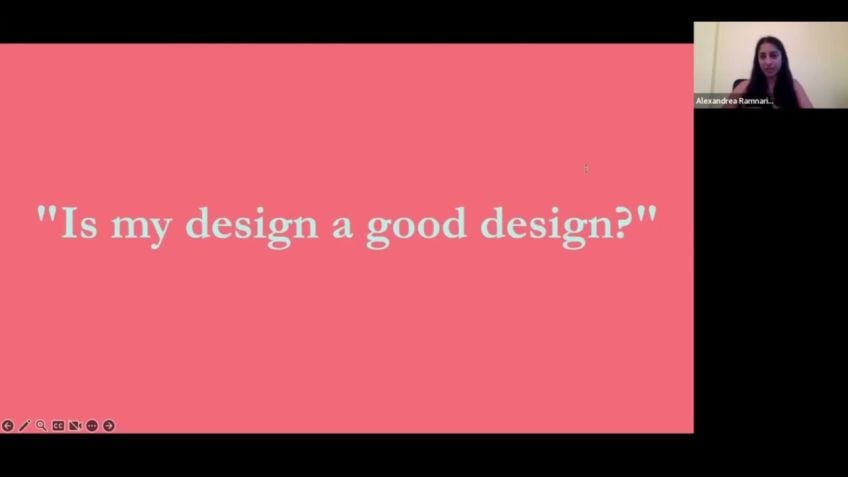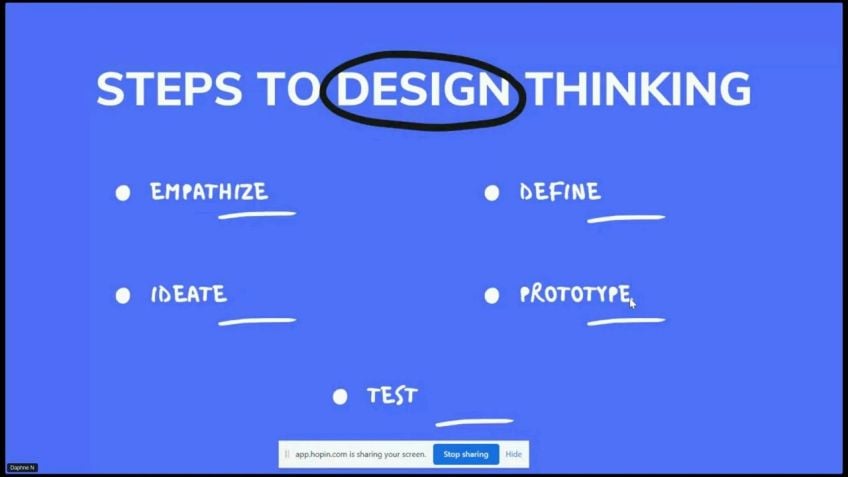Innovation From the Lense of Design Thinking
Cracking the Code of Innovation: A Guide to Design Thinking
Design thinking is a powerful tool to foster innovation — regardless of your professional field or level of experience. From primary school students to industry executives, anyone can benefit from this creative problem-solving technique. This article offers an overview of design thinking and how it can revolutionize your approach to challenges and ideation.
-
Demystifying Design Thinking
Contrary to popular belief, design thinking is not exclusive to designers. It's a versatile problem-solving technique that promotes creativity, collaboration, and empathy. The key to its effectiveness lies in the fluid process, which encourages the thinker to empathize with end users and ideate without fear of judgment. No idea is wrong in this stage of design thinking, encouraging even the most unconventional thoughts.
The Design Thinking Loop
Design thinking is a cyclic process that comprises several stages:
- Identifying the Problem: Understanding the needs and problems of your users or clients forms the base of design thinking. Observation, interviews, focus groups, or user research are effective techniques to gain this understanding.
- Empathy: You must put yourself in your users' shoes and see the problem from their perspective. By humanizing these needs, the solutions generated are more precise and effective.
- Ideation: In the ideation stage, no idea is considered wrong or ridiculous. Teams are encouraged to think outside the box and record all ideas, regardless of their apparent practicality.
- Prototyping: A prototype, which could be a basic wireframe, a drawn layout, or even a Lego model, helps visualize the functionality of your idea. Essentially, anything that explains the functionality of your idea can serve as a prototype.
- Review: The next step is to assess if the prototype addresses the identified needs and problems. If it doesn't, it's back to ideation again.
Managing the Influence in Brainstorming
One common issue teams encounter during brainstorming sessions is the unintended influence of authority figures or more dominant personalities, stifling the free exchange of ideas. To mitigate this, encourage everyone to write down their ideas individually; then anonymously share and vote on them. This approach not only mitigates any potential influence but also facilitates a democratic selection of the best ideas.
Taking Design Thinking One Step Further
Design thinking doesn't end with the identification of a viable solution—it also involves rigorous testing and validation. If it doesn't address the user's needs, the process repeats, with a renewed focus on understanding the exact problem and conceiving a tailored solution.
Innovation stems from this iterative pursuit of better solutions, all the while keeping your end-users—the real people who are going to use your product or service—at the heart of the process.
Video Transcription
Um Today, I, I will be talking about um design thinking and um how design thinking can um help us uh going for innovations. My topic is innovation from the lens of design thinking. Actually, there is no moderator for the session.So I'm not sure if uh if you can hear me or how, how is it going? I am not sure about anything. I am just speaking and um let's see where it goes. So, yeah, so um I don't know if how uh how many of you are aware with design thinking. I have been working with IBM for um for more than 778 years now. Um So I have been working as a digi digital transformation consultant for IBM. Um My, my focus area is design thinking and, and uh digital transformation of the projects uh from traditional ways of working to um digitizing the processes and um um all the different streams including people in operations. Um So um one of one of the things that I wanted to share here with you guys was that um how um design thinking forms um the base for innovation for any of the industry or any of the clients. So one very common misconception with design thinking is that design thinking is something that is solely for the designers uh which is something that is very design thinking is not something that, that is only for the designers.
A design thinking can be practiced by um uh even by the uh the uh it's just a problem solving technique and it can be followed even by um the students of um uh primary um classes. So we did, we did this experiment once and um where we, where we did a very basic level um uh of a workshop with the students of uh primary um education level. And uh we gave them some small assignments of ideation of coming up with new ideas um of, you know, um how, how the city should be in the classroom and how um how they should uh you know, um how, how, what, what should be the environment of the classroom, they should come up with the new ideas, then they come up with the really, really great ideas.
So, uh design thinking is not only for the designers, anybody who is working in any industry and uh is any ways related to solving any kind of problem um can use design thinking as a problem solving technique. So how do we start with design thinking? Um The way we work with design thinking is uh it has, it's a, so it comes in the process of a loop. Um It starts from uh it starts from uh def defining um that what is the problem uh creating a point of view um based of the user needs and insights. So you can explore user needs and insights um by uh conducting interviews or just by observing. So if, if you're a leader and, and um you want to come, uh you want to understand the, the problems of your um employees or you want to understand the problems of your customers, there are different techniques that you, you can use. You can either interview your customers or you can um just observe um your clients or your customers and try to understand what is the problems there and what are the problems there? If you want to do it in a more structured way, then definitely you can ask them questions or you can spend time with them, you can do focus groups, anything, any um exponential research or any direct research that you want to do, you can go for that.
Um And then um once you have a point of view, you try to think um uh you try to empathize, um you try to um humanize the those needs. Uh So um you have to understand, you have to say that if, if, if I am the person who is facing this problem, um then, then how um I would, I think of the solution um not uh as my customers are facing this problem. So, you know, they are from this industry. So this should be the solution now, uh not from that point of view. So you need to understand the end users uh problems and the end users, you need to think uh like end user things and then you, you know, you need to sympathize with them. And then uh you, there comes the ideation stage where you brainstorm um and the ideas when you're coming up with the solutions. So, uh one of the things that we say in, in design thinking is that um you ideate um no idea is wrong um in design thinking. So, um at times what happens is when we are idea or regulating the ideas, we just pick, pick a piece of paper and we pick uh and we pick a pen and then, you know, we start writing ideas and then uh in our own head, we think um no, this idea is that this might not work or, you know, this might be something stupid.
Um uh You know what, let me discuss it. So, uh so this is, this is what we do usually, right? Um uh This is uh this is something that um that we should not be doing in design thinking. Um The, the uh the ideas are going to be, we, we're going to review the ideas later on, but whatever idea, anything stupidest that you can think of uh that comes to your mind. Um you are going to uh write that um in onto the piece of paper and stick that onto the wall and just give it a good look afterwards. So, do not discard the ideas which are right in your brain at the, at the, at the very beginning. And then once you are, once you are done with all of your ideas, then you, um then you think that uh if you connect multiple ideas, does that make a big idea? And does that make sense or even a small idea or the chunk of ideas or what you can keep or what you can discuss? But that is the next stage. Um You just do, not, once you're coming up with the idea, just keep coming with the ideas and just putting them on the paper and just uh keep posting them onto the wall when we do this exercise with uh with our teams, uh where we have like multiple, well, um 1516, even up to 15 people come up with great ideas, such diversity of ideas and such diverse minds.
Um One thing also that I would like to mention here is when, whenever you do an anything and be brainstorming because we usually, we just, we, we're calling everything putting together and calling a design thing here. But when we think of something, uh you're working in a team or you're working with your, you know, um boss or somebody you are coming up with a brain, uh, with the ideas and suddenly, uh, for example, you are the boss and you come up with an idea. Um, ok, I think we should do it this way. Um, or probably, you know, um, we're doing something manually. I think we should, uh, we should, uh, start doing it on, uh, you know, instead of conversing with each other, just put it, start putting it on email. Just one big, big thing. I'm coming up with instantly, everybody in the room is going to be uh saying yes, boss, you're right. Um Is something that we're, we're against here. Um We, we say that there should be no influence. Um Coming up to the ideation stage. That is why um we mentioned that uh you know, whenever you're doing the brainstorming, just try to uh not um influence each other or voice out, voice out your ideas, like very loud and clear, just write your ideas or even even better if you can draw your ideas for the vi uh so you can visualize your ideas later on and just do that on a piece of paper.
Don't voice it out just right now, you're going to uh be taking care of the uh of the ideas um later on when you're reviewing them without taking names that who came up with the idea. So there is no influence um uh onto the team and there's no pressure on them. Um Then we have um the, then we have the stage where we uh where we make prototypes of these ideas. So what is a prototype or how or what is a minimum bi product? So a prototype is something that is in a very, very um basic form and uh is working. Uh So it gives you an idea, it can be a wireframe, it can be something as simple as something drawn on a piece of paper. Just giving an idea. For example, if you're digitizing something, maybe uh maybe you're digitizing a mobile application. Uh So maybe this can be a demo um of the application, uh something like that. So it can be anything a blueprint can, can be a prototype, um uh something physical, something made out of lego can be a prototype as well. Just something that explains the functionality of your idea is going to be called a prototype. And when you, when you, when you came up with a prototype, then you're going to test it that how is it going to fulfill the needs that you identify here?
Um are, is it, is it fulfilling those needs that you identified here? If it's, if it is fulfilling the needs that you identify here, good. If it's not, then the loop, then you, then you go down into the loop again, then you again think of your needs and again, empathize with the customers and uh look at, look back at your ideas and then uh come up with um come up with more um you know, collated information and um start redoing your prototype and come up with something until you find best uh best prototype and then you take it and then you um uh then you go for your final product or your final solution of the problem.
So this is what something um uh something very small um uh about design thinking that I wanted to share with everyone of you. Now, if you have any questions, I would like to answer your questions. I think my time is also going to be over in four minutes. So let's have some questions um If there are any. Yes. Um So, um yeah, yes, it is. Uh It is very much like brainstorming. So I, I, as I mentioned that um uh it's just we're just uh taking four major things here and just putting them together and then calling them brain brainstorming. So this is how it is. Um And nothing um Nothing uh different. Anything else? Oh, that is great. Uh Rebecca. Yes. Uh So respectfully manage the influence of boss the loudest person. So one thing that I would, that I would say right away is when you're doing a design thing exercise, just um uh lay a charter of uh um lay a charter of, you know, um um And the way you're going to do things or the values, call it values or, or this is how we are going to do things.
Um Just tell them right ahead that we're not going to disclose our ideas or make it sound like a game. So, you know, we're not going to disclose our ideas, we disclose our ideas. Um You know, um uh we'll just uh show all the ideas and get, you know, uh insights from everybody that, what do they think? One exercise that we do with this kind of thing is we just call blind voting in blind quoting. What do we do is that we put everybody's ideas on the board without telling that the whose idea is this? And then every member of the team has a green uh sticker and a red sticker. They come up with a green sticker and a red sticker. And um you know, uh wherever they think that uh they, they like this idea, they put a green sticker on that and wherever they think there, there is something you know, concerning or it's, it's not right or, you know, it can cause some issue or something like that or even if you're, if you're thinking about boss, um don't go with the red red sticker, just go with the green stickers.
And the one idea which is, which has the most green stickers or 23 ideas with the more like uh more green stickers just um take them. And uh that is how that is how you're going to pick the ideas. And that is how you can avoid the loudest person in the room as well. Yes. Um Joanna, you're right. Absolutely right. It is bringing it is all about bringing your consumer, your customer um to the core of whatever you're going to be making the solution um for them. I'm glad Rebecca you like it. Um We usually do it with the clients because uh when we are doing it, we are usually the CEO S or the, you know, very, very high end stakeholders are in the room and the teams are very reluctant to speak in front of them. Um So we tell them that this is a game. Uh We're, we're playing a game here and then the moment you tell them, you know, this is a game or something like that, you make it more like that uh sound like that and uh they're like, oh yeah, yeah, fine. It's going to be fun.
And in that fun factor, you come down to the real thing. All right guys, I think my time is over as well. If you have any questions, you have my linkedin um profile um uh as well. You can connect with me. Design thinking is um uh uh I would say that it is um bringing outcomes at speed and scale, keeping the humans at heart of it. So you're not designing solutions for uh for um a company or an organization or somebody like that, you're not designing anything you're designing for solutions um solutions for Nan who is using the product. Um You're not, uh you're not coming up with the solutions um for any company or any organization, you're coming up with the solutions for the person who's going to be using the entire the end product or the end service. That's what, how I would put it in my engine. Thank you, everyone. Thank you. It was great connecting with all of you. If you have any questions about design thinking or you like to connect to me, you have my linkedin into the uh into my profile. Um I would be very happy if you want to connect with me and uh let's uh let's stay connected. Thank you so much, everyone.





